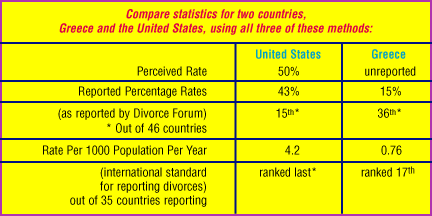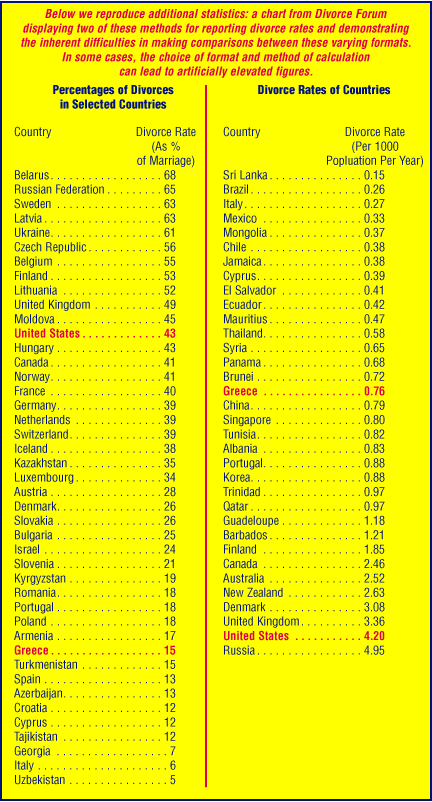 |
||
| Divorce Rates for Greek Orthodox Couples Below National Average But Measurement Problems Make Interpretation Difficult By Christos and Mary Papoutsy Founders and Publishers, Hellenic Communication Service |
||
Recently, the Greek Orthodox Archdiocese of America released its publication of the 2001 Yearbook in which faithful can find a wealth of information pertaining to Orthodoxy. Filling more than 250 pages and generally serving as a reference source, this volume also includes statistics on marriages and divorces. During a period of 23 years over which figures were compiled by the Archdiocese, there were 121,587 marriages and 16,981 divorces. Using these figures alone, the divorce rate would be 14% of the total Orthodox marriages, falling far below the US national average of approximately 43%. Adding to the complexity of the issue is an erroneous perception among the general populace in the United States that the overall divorce rate is more than 50%. The disparity between all of these rates naturally invites additional questions and examination, especially as they apply to Orthodox Christians. Archdiocesan Statistics Reflect Church, But Not Civil, Divorces Father Charles Joanides of the Archdiocese has helped to clarify this issue: "One cannot arrive at a divorce rate [for Orthodox faithful] from the Archdiocesan published statistics because they only reflect the number of Church divorces that were issued during this period and do not track the number of civil divorces." In other words, there is no underlying common denominator or basis for comparison between the reported figures for Orthodox Christians and those for the entire national population, so these percentages (14% and 43%) cannot be used. To do so would be like trying to compare apples and oranges. Nevertheless, Father Joanides’ remarks suggest plausible reasons for the disparity in the two rates. The key to understanding these causes may be found in the methods of registering Orthodox divorces. Orthodox faithful generally apply for ecclesiastical divorces after receiving civil divorces. When the ecclesiastical divorces are granted, these are recorded among Archdiocesan records, adding to the annual statistics reported. What go unregistered, however, are the records of those Orthodox Christians who do not apply for an ecclesiastical divorce after receiving a civil divorce. Thus, the number of Orthodox Christians who consider themselves divorced may be much higher than the figures reported by the Archdiocese, if there are significant numbers of Orthodox Christians with civil divorces who have not later sought ecclesiastical divorces. If we multiply the total number of Greek Orthodox marriages reported by the Archdiocese during the last 23 years (121,587) by an estimated average of the US national overall divorce rate during that same interval (47%) and then subtract the reported Greek Orthodox divorces of that period (16,981), we come up with a ballpark figure of 40,165. That means simply that there may be as many as another 40,000 Orthodox Christians who have obtained only civil divorces and who have not applied for or received ecclesiastical divorces. Could the figure be higher than 40,000? It is possible, but seems unlikely in the absence of any evidence suggesting that the divorce rate among Orthodox faithful is higher than the national average. Furthermore, the divorce rate among Orthodox Christians in Greece is much lower than the overall national average in the US—at 15% it ranks among the lowest of the countries whose statistics are reported. This would lend additional weight to the notion that the rate for Greek Orthodox Christians in the US ought to be no higher than the overall national average. Measurement Methods Raise Questions Clouding this issue of divorce statistics are methods of reporting and measuring divorce rates. The most commonly employed method internationally is to cite the rate for every 1,000 or 100,000 people in the target countries. These rates, therefore, are not reported in percentages. Recently, in the US this rate has been 4.6 per 1,000 people in the national population. The chief problems with this measure, however, are that it is sensitive to a population age distribution and that it does not take into account the fact that the divorces in one interval may not be connected with the marriages recorded during that same timeframe. In other words, a divorce reported in one year may be the end of a 15-year marriage, while one or all of the marriages cited in this same year may never result in divorce. Another method of measuring divorces likewise presents difficulties. With this procedure, the number of divorces in one year is simply set over (divisor) the number of marriages that have taken place during the same interval. The resulting statistic is rather easily misinterpreted. For if the number of marriages decreases, even if the number of divorces remains the same, the proportion of divorces will increase. In yet other cases, perceived rates of divorce are used for purposes of discussion. These obviously are the least objective and least reliable. As we had mentioned above, most people in the US believe the national divorce rate to be at least 50%, or one out of every two marriages. Is this true? Definitely not! Dr. Anne-Marie Ambert of York University clearly refutes this popular misconception, indicating that the current US divorce rate is 43%.
Closely related to these divorce statistics are the figures reported by the Archdiocese on marriages. It is not coincidental that they appear side by side in the 2001 Yearbook charts. What is particularly interesting about them is that they are subject to similar difficulties in reporting and interpretation. Nearly all of the same disadvantages and problems can be found in manipulating and interpreting these figures, too, both in terms of the Archdiocese statistics and in terms of the numbers for the overall general population. Furthermore, none of the Archdiocese statistics includes records of those Orthodox Christians who obtained only civil unions (or unions through other religious rites), and not Orthodox ecclesiastical marriages. Rise in Interfaith Marriages The underlying common thread in the Archdiocese statistics on both marriages and divorces, apart from the inherent difficulties in interpreting the statistics themselves, is that there are unknown numbers of Orthodox Christians who have chosen to marry outside the Church and/or who have not obtained ecclesiastical divorces. Although no methods exist for determining accurately the total number of civil and ecclesiastical marriages or divorces, it is possible for the Archdiocese to make useful observations from their own reported figures. For example, the relative numbers of registered interfaith marriages have grown over the last few decades. They now comprise over 60% of the marriages recorded yearly by the Archdiocese. In response to this trend, the Archdiocese has developed specific policies to address this growing need among Orthodox faithful. Very commendably, the Archdiocese views this situation as an “opportunity for growth, rather than [as] a problem,” and “with love toward all, and a vigor to[ward] witness[ing] Orthodoxy,” it has taken a “proactive approach in its efforts to reach out to intermarriage couples and their families,” according to Rev. Dr. Charles Joanides, LMFT, a researcher for the Archdiocese. The proactive approach of the Archdiocese has focused upon implementing concrete educational steps. For example, qualified experts and clergy have written many hundreds of articles on these topics. In the most recent edition of the Orthodox Observer (March-April 2001), there was an article by Fr. Joanides, just one of his many timely and worthy contributions (“Interfaith Marriages. Costa’s and Teresa’s Dilemma When Children Mature.”). We recommend another essay of his, “The Interfaith Marriage Challenge,” which can be viewed and downloaded, along with many other essays covering a broad spectrum of religious and social issues, from the website of the Archdiocese at http://www.goarch.org. Additional articles and reports can be found in the 2001 Yearbook of the Greek Orthodox Archdiocese of America. (The price is $18.00 each, with $3.00 S/H per book; contact Holy Cross Bookstore by fax at 617-850-1230 or by email HCBKS@omaccess.com.) Parishes Help Prepare Newlyweds Every Greek Orthodox parish in the United States under the auspices of the Archdiocese of America, has instituted a successful premarital preparation program for all couples planning to get married. While these sessions will not ensure against or eliminate marital conflicts or strife, nonetheless they do assist couples in opening frank dialogues about their lives together. With qualified clergy, couples discuss critical topics, including the challenges of adhering to the same religion or to differing faiths, using questionnaires developed by the Archdiocese as guidelines for discourse. We can vouch for the timeliness of these sessions, having undergone them ourselves in preparation for our own marriage. We recall being impressed with the scope and frankness of the questions and their ability to ferret out differences in attitude among couples toward important elements of marriage and the upbringing of children. Clearly, efforts are underway to assist Orthodox faithful with their marriages and the collection of data is one of these means. While not definitive, the statistics nevertheless yield some useful observations in addressing the needs of parishioners. For example, in response to trends highlighted by the data, the Archdiocese has embarked on an educational campaign to assist couples of interfaith marriages. Premarital sessions have been established for couples intending to marry; many educational articles and essays have been penned and made available to Orthodox Christians and their families. Although indications suggest that divorce rates are on the rise, both nationally and among Orthodox families, other data leads us to believe that the rate among Orthodox Christians may very well be lower than the overall US national average. A very low rate among Orthodox Christians in Greece tantalizes us into believing that connections spiritually and ethnically with our sister Church can also suggest a lower rate for Greek Orthodox Christians in the US. Whether or not this may be true, however, remains to be seen, without objective figures to substantiate or refute it. Familial and Religious Ties Reinforce Marriage Yet, we feel comfortable in supposing that the number of divorces among Orthodox couples is lower. It is our perception that it must be so. Why? We feel that a couple, both of whom have been raised in the same faith, will not experience difficulties rooted in conflicts over faith. Instead of posing challenges, we believe that familial and religious surroundings can help reinforce the marriage: the couple will attend Church together; children will be reared in Orthodoxy like the rest of the family; children will have a better opportunity to learn about and participate in Greek cultural traditions. Are these guarantees that the marriages will last? Unfortunately, they are not. The phenomenon of divorce is still a very complex issue, probably even more complex than generally acknowledged. Statistics cannot answer all of the questions surrounding divorce. Collection of the data itself is incomplete, with no means existing nationally or among Orthodox faithful for obtaining accurate and definitive numbers. Care must be exercised when interpreting data, since there are widely varying methods of displaying and calculating figures for divorce and marriage rates. Despite these difficulties, general observations may be drawn from the changes of data over time. The Archdiocese has noticed certain general trends from its own reported statistics and has responsibly taken steps to address these changes. Through educational material and participation in premarital sessions, our hierarchy reaches out proactively to all Christians to envelop them into the folds of Orthodoxy. For a more comprehensive understanding on this subject, contact your local Parish priest and/or the nearest Diocese center in your area. For those Orthodox Christians located in the New England area, call the Greek Orthodox Diocese of Boston, 617-277-4742, email the staff at bostondiocese@internet.goarch.org, or visit their website at http://www.bostondiocese.org. His Eminence Metropolitan Methodios of Aneon is the presiding Hierarch of Boston. |


